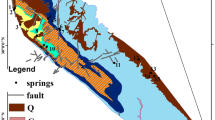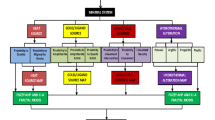Abstract
The main aim of this study is to determine the location of the cave and cavities in Zarrinabad area, Lorestan province, west of Iran. For this purpose, a combination of hybrid AHP-TOPSIS procedure and content-area (C-A) fractal method has been conducted on three types of geoelectrical data derived from electrical resistivity, self-potential and mise-a-la-masse methods to detect karstic zones and determining the geometry of the cavities. Initially, the raw values of the data were transformed to [0–1] domain using the MSlarge fuzzy function, and then the fuzzified values were discretized applying C-A fractal model to separate different geological populations (e.g., conglomerate and limestone layers as well as the geometry of the cave). Subsequently, the analytical hierarchy process (AHP) as the most widely used multiple criteria decision making (MCDM) technique was applied for calculating meaningful weights and then assigning them to different fractal-based classes of investigation criteria (here, triple geoelectrical data) based on the expert knowledge. A decision matrix based on the calculated weights were constructed and TOPSIS as another well-known MCDM technique was then employed for generating cave potential model of AHP-TOPSIS procedure. In addition, a fuzzy Gamma model (gamma = 0.9) based on three fuzzified electrical layers is implemented to assess the AHP-TOPSIS model. Finally, for the evaluation of generated models, electrical resistivity sections along profile 1, 2 and 3 were prepared. The results exhibit a strong spatial association between final prospectivity models, electrical resistivity sections and the outcrop of the cave on the surface. According to the obtained results, a cave with dimensions of several meters (for example, its length in one direction is up to 100 m) is appeared to be expanded from the north of the study area to the south. Besides, it is possible that the karstic zones contain a number of small cavities which are linked together like a beehive. Thus, this area can be considered as a good source of underground water due to the presence of these holes which often contain fresh water. In addition, this area is prone to convert into a tourism area in the future as this cave contains high level water especially in rainy seasons.












Similar content being viewed by others
References
Abedi M, Norouzi GH (2016) A general framework of TOPSIS method for integration of airborne geophysics, satellite imagery, geochemical and geological data. Int J Appl Earth Obs 46:31–44
Abo-Sinna MA, Amer AH (2005) Extensions of TOPSIS for multi-objective large-scale nonlinear programming problems. Appl Math Comput 162:243–256
Afzal P, Khakzad A, Moarefvand P, Rashidnejad Omran N, Esfandiari B, Fadakar Alghalandis Y (2010) Geochemical anomaly separation by multifractal modeling in Kahang (Gor Gor) porphyry system, Central Iran. J Geochem Explor 104:34–46
Afzal P, Mirzaei M, Yousefi M, Adib A, Khalajmasoumi M, Zarifi AZ, Yasrebi AB (2016) Delineation of geochemical anomalies based on stream sediment data utilizing fractal modeling and staged factor analysis. J Afr Earth Sci 119:139–149
Amini A, Ramazi H (2016a) Anomaly enhancement in 2D electrical resistivity imaging method using a residual resistivity technique. J S Afr I Min Metall 116(2):161–168
Amini A, Ramazi H (2016b) Application of electrical resistivity imaging for engineering site investigation. A case study on prospective hospital site, Varamin, Iran. Acta Geophys 64(6):2200–2213
Amini A, Ramazi H (2017) CRSP, numerical results for an electrical resistivity array to detect underground cavities. Open Geosci 9(1):13–23
Bai J, Porwal A, Hart C, Ford A, Yu L (2010) Mapping geochemical singularity using multifractal analysis: application to anomaly definition on stream sediments data from Funin Sheet, Yunnan, China. J Geochem Explor 104(1–2):1–11
Bonham-Carter GF (1994) Geographic information systems for geoscientists: modeling with GIS. Pergamon Press, Oxford, p 398
Chalikakis K, Plagnes V, Guerin R, Valois R, Bosch FP (2011) Contribution of geophysical methods to karst-system exploration: an overview. Hydrogeol J 19(6):1169
Chamberlain AT, Sellers W, Proctor C, Coard R (2000) Cave detection in limestone using ground penetrating radar. J Archaeol Sci 27(10):957–964
Chen SJ, Hwang CL (1992) Fuzzy multiple attribute decision making methods. Fuzzy multiple attribute decision making. Springer, Berlin, pp 289–486
Cheng Q, Agterberg FP, Ballantyne SB (1994) The separation of geochemical anomalies from background by fractal methods. J Geochem Explor 51(2):109–130
Daneshvar Saein L, Rasa I, Rashidnejad Omran N, Moarefvand P, Afzal P (2012) Application of concentration-volume fractal method in induced polarization and resistivity data interpretation for Cu-Mo porphyry deposits exploration, case study: nowchun Cu-Mo deposit, SE Iran. Nonlinear Proc Geophys 19(4):431–438
Daviran M, Maghsoudi A, Cohen DR, Ghezelbash R, Yilmaz H (2020) Assessment of various fuzzy c-mean clustering validation indices for mapping mineral prospectivity: combination of multifractal geochemical model and mineralization processes. Nat Resour Res 29(1):229–246
Ferdows MS, Ramazi H (2015) Application of the fractal method to determine the membership function parameter for geoelectrical data (case study: Hamyj copper deposit, Iran). J Geophys Eng 12(6):909–921
Ford DC, Williams PW (1989) Karst geomorphology and hydrology, vol 601. Unwin Hyman, London
Ghezelbash R, Maghsoudi A (2018a) A hybrid AHP-VIKOR approach for prospectivity modeling of porphyry Cu deposits in the Varzaghan district, NW Iran. Arab J Geosci 11(11):275
Ghezelbash R, Maghsoudi A (2018b) Comparison of U-spatial statistics and C-A fractal models for delineating anomaly patterns of porphyry-type Cu geochemical signatures in the Varzaghan district, NW Iran. Comptes Rendus Geosci 350(4):180–191
Ghezelbash R, Maghsoudi A, Daviran M (2018) Prospectivity modeling of porphyry copper deposits: recognition of efficient mono-and multi-element geochemical signatures in the Varzaghan district, NW Iran. Acta Geochim 38(1):131–144
Ghezelbash R, Maghsoudi A, Carranza EJM (2019a) Mapping of single-and multi-element geochemical indicators based on catchment basin analysis: application of fractal method and unsupervised clustering models. J Geochem Explor 199:90–104
Ghezelbash R, Maghsoudi A, Daviran M (2019b) Combination of multifractal geostatistical interpolation and spectrum–area (S–A) fractal model for Cu–Au geochemical prospects in Feizabad district, NE Iran. Arab J Geosci 12(5):152
Ghezelbash R, Maghsoudi A, Daviran M, Yilmaz H (2019c) Incorporation of principal component analysis, geostatistical interpolation approaches and frequency-space-based models for portraying the Cu-Au geochemical prospects in the Feizabad district, NW Iran. Geochemistry 79(2):323–336
Hwang CL, Yoon K (1981) Methods for multiple attribute decision making. Multiple attribute decision making. Springer, Berlin, pp 58–191
Jahani Behbahani H (1993) The role of lineaments in controlling groundwater flow in karstic regions folded. Doctoral dissertation, MS Thesis, Earth Sciences Department, Shiraz University, Persian
Jahanshahloo GR, Lotfi FH, Izadikhah M (2006) Extension of the TOPSIS method for decision-making problems with fuzzy data. Appl Math Comput 181(2):1544–1551
Jardani A, Revil A, Dupont JP (2006) Self-potential tomography applied to the determination of cavities. Geophys Res Lett 33:3401
Jardani A, Revil A, Santos F, Fauchard C, Dupont JP (2007) Detection of preferential infiltration pathways in sinkholes using joint inversion of self-potential and EM-34 conductivity data. Geophys Prospect 55(5):749–760
Lobo HAS, Trajano E, de Alcântara MM, Bichuette ME, Scaleante JAB, Scaleante OAF et al (2013) Projection of tourist scenarios onto fragility maps: framework for determination of provisional tourist carrying capacity in a Brazilian show cave. Tour Manag 35:234–243
Malczewski J (1999) GIS and multicriteria decision analysis. John Wiley & Sons, Hoboken
Mays LW (2013) Groundwater resources sustainability: past, present, and future. Water Resour Manag 27(13):4409–4424
Metwaly M, AlFouzan F (2013) Application of 2-D geoelectrical resistivity tomography for subsurface cavity detection in the eastern part of Saudi Arabia. Geosci Front 4(4):469–476
Novas N, Gázquez JA, MacLennan J, García RM, Fernández-Ros M, Manzano-Agugliaro F (2017) A real-time underground environment monitoring system for sustainable tourism of caves. J Clean Prod 142:2707–2721
Panthulu TV, Krishnaiah C, Shirke JM (2001) Detection of seepage paths in earth dams using self-potential and electrical resistivity methods. Eng Geol 59(3–4):281–295
Parsa M, Maghsoudi A, Ghezelbash R (2016) Decomposition of anomaly patterns of multi-element geochemical signatures in Ahar area, NW Iran: a comparison of U-spatial statistics and fractal models. Arab J Geosci 9(4):260
Ramazi HR (2005) Combined resistivity sounding and profiling and its application in mineral exploration and site investigation. Tehran (in persian)
Ramazi HR, Jalali M (2014) Contribution of geophysical inversion theory and geostatistical simulation to determine geoelectrical anomalies. Stud Geophys Geod 59(1):97–112
Ramazi HR, Mostafaie K (2013) Application of integrated geoelectrical methods in Marand (Iran) manganese deposit exploration. Arab J GEOSCI 6(8):2961–2970
Saaty TL (1980) Analytic hierarchy process. John Wiley & Sons Ltd, Hoboken
Shawkat A, Carpenter P (2003) Geophysical response of filled sinkholes, soil pipes and associated bedrock fractures in thinly mantled karst, east-central Illinois. Environ Geol 44:705–716
Shih HS, Shyur HJ, Lee ES (2007) An extension of TOPSIS for group decision making. Math Comput Model 45(7–8):801–813
Stokes T, Griffiths P, Ramsey C (2010) Karst geomorphology, hydrology, and management. In: Compendium of forest hydrology and geomorphology in British Columbia, Land management handbook, 66:373–400
Tavana M, Hatami-Marbini A (2011) A group AHP-TOPSIS framework for human spaceflight mission planning at NASA. Expert Syst Appl 38:13588–13603
Zadeh LA (1965) Information and control. Fuzzy sets 8(3):338–353
Zimmermann HJ, Zysno P (1980) Latent connectives in human decision making. Fuzzy Sets Syst 4(1):37–51
Author information
Authors and Affiliations
Corresponding author
Additional information
Publisher's Note
Springer Nature remains neutral with regard to jurisdictional claims in published maps and institutional affiliations.
Rights and permissions
About this article
Cite this article
Akbari, S., Ramazi, H., Ghezelbash, R. et al. Geoelectrical integrated models for determining the geometry of karstic cavities in the Zarrinabad area, west of Iran: combination of fuzzy logic, C-A fractal model and hybrid AHP-TOPSIS procedure. Carbonates Evaporites 35, 56 (2020). https://doi.org/10.1007/s13146-020-00586-5
Accepted:
Published:
DOI: https://doi.org/10.1007/s13146-020-00586-5




